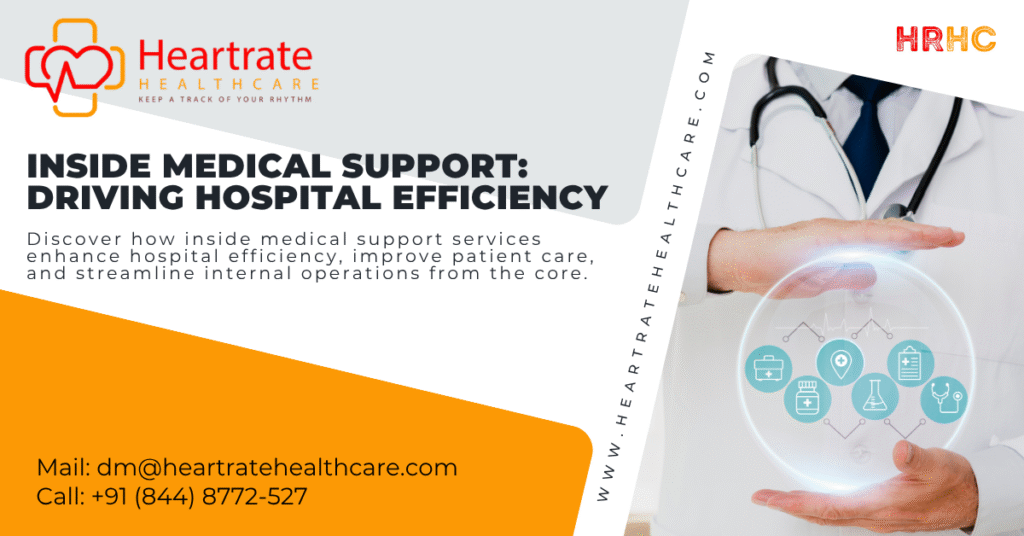In today’s fast-paced healthcare environment, hospitals face growing pressure to improve patient outcomes, reduce costs, and maintain high standards of care. One often overlooked yet crucial factor in achieving these goals is Inside Medical Support (IMS)—a comprehensive system of internal operations, administrative services, and clinical support that works behind the scenes to ensure hospitals run efficiently.
From medical transcription to billing, coding, and IT support, IMS is the backbone of hospital operations. This article explores how inside medical support plays a vital role in boosting hospital efficiency and what strategies can optimize its impact.
What is Inside Medical Support?
Inside Medical Support encompasses a range of non-clinical and clinical services that are managed within the hospital’s internal framework. Unlike outsourced support, IMS functions directly under hospital management, offering real-time, integrated assistance to healthcare professionals.
Key components include:
- Medical Billing and Coding
- Electronic Health Record (EHR) Management
- IT and Technical Support
- Clinical Documentation
- In-House Call Center Support
- Inventory and Supply Chain Coordination
- Scheduling and Administrative Coordination
The Strategic Role of IMS in Hospitals
IMS is more than just a back-office operation—it is a strategic partner in delivering quality care. Let’s break down how IMS boosts efficiency:
1. Streamlining Administrative Tasks
Accurate documentation, quick patient registration, appointment scheduling, and insurance verification are all handled more smoothly through effective IMS. This reduces delays and improves patient satisfaction.
2. Enhancing Clinical Workflow
With trained support staff managing EHR systems and clinical documentation, doctors and nurses can focus on patient care instead of paperwork. This leads to better treatment outcomes and reduced burnout among healthcare providers.
3. Improved Communication and Coordination
IMS fosters seamless communication between departments. For example, in-house call centers ensure faster internal communication, enabling departments to respond promptly to emergencies or changes in treatment plans.
4. Real-Time Problem Solving
Since IMS is within the hospital infrastructure, problems can be identified and solved in real time. This contrasts with outsourced support, where turnaround times can be longer due to communication lags.
The Impact on Patient Care
A well-functioning inside support system directly improves the patient experience by:
- Reducing wait times
- Preventing errors in records and billing
- Providing timely test results
- Ensuring coordinated care across departments
When internal systems operate smoothly, it builds patient trust and reflects positively on hospital reputation.
Technology’s Role in Inside Medical Support
Modern hospitals rely on digital tools and automation to elevate IMS capabilities. Some examples include:
- AI-Driven EHR Systems: Help automate routine tasks and flag anomalies.
- Hospital Information Systems (HIS): Integrate patient data, lab reports, pharmacy info, and more.
- Telehealth Integration: Ensures IMS staff can support virtual consultations by managing backend workflows.
Automation also reduces human errors and ensures better compliance with healthcare regulations.
Training and Workforce Development
One of the biggest assets of IMS is a well-trained support staff. Hospitals investing in continuous training for IMS roles experience:
- Lower employee turnover
- Increased accuracy in billing and records
- Greater adaptability to new technologies and processes
A knowledgeable support team ensures smoother transitions during policy changes or emergencies like pandemics.
Challenges in Inside Medical Support
Despite its benefits, IMS can face hurdles such as:
- High initial investment in technology
- Resistance to change among staff
- Maintaining data privacy and HIPAA compliance
- Shortage of skilled workers
To overcome these, hospitals must develop clear policies, invest in training, and foster a culture of collaboration between clinical and support teams.
Future Trends in Inside Medical Support
The future of IMS is poised to become more integrated, tech-driven, and patient-centric. Some emerging trends include:
- Use of Machine Learning in billing error detection
- Cloud-Based Systems for unified data access
- Predictive Analytics for resource management
- Robotic Process Automation (RPA) for repetitive administrative tasks
These advancements will further streamline hospital operations, reduce costs, and enhance the quality of care delivery.
Conclusion
Inside Medical Support is an invisible engine that powers hospital efficiency from the inside out. As hospitals continue to evolve, investing in robust IMS strategies will not only improve internal workflows but also elevate the standard of patient care.
Whether it’s through better coordination, real-time tech support, or faster documentation, IMS ensures that hospitals remain agile, responsive, and patient-focused in an ever-demanding healthcare environment.


